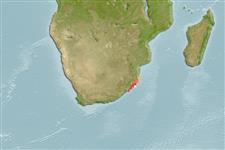Elasmobranquios (tiburones y rayas) (sharks and rays) >
Rajiformes (Skates and rays) >
Gurgesiellidae (Pygmy skates)
Etymology: Cruriraja: Latin, crur, cruris = pertaining to a leg + Latin, raja = a ray (Raja sp) (Ref. 45335).
Environment: milieu / climate zone / depth range / distribution range
Ecología
marino batidemersal; rango de profundidad 150 - 620 m (Ref. 11284). Deep-water; 28°S - 40°S
Western Indian Ocean: KwaZulu-Natal, South Africa to Mozambique. Previous records from Namibia to the Eastern Cape Coast of South Africa refer to Cruriraja hulleyi.
Tamaño / Peso / Age
Maturity: Lm ? range ? - ? cm
Max length : 55.0 cm TL macho / no sexado; (Ref. 5578)
Short description
Claves de identificación | Morfología | Morfometría
A rough legskate with a pointed snout covered by large conspicuous white thorns that are also found around the eyes, on the shoulders, and in several rows from the nape to the 1st dorsal fin (Ref. 5578). Legskates have pelvic fins separated into a mobile leg-like front lobe, and a rear lobe that may be fused to the tail base (Ref. 5578). Sandy brown above usually with scattered dark brown and whitish spots (very conspicuous in young and becoming obscure in adults; white below (Ref. 5578). Tail with conspicuous dark brown bandings in juveniles (Ref. 5578).
Found on the uppermost slope (Ref. 5578). Feed on small crustaceans, dragonets, squid, polychaete worms and flatworms (Ref. 5578). Oviparous. Distinct pairing with embrace. Young may tend to follow large objects, such as their mother (Ref. 205). Eggs are oblong capsules with stiff pointed horns at the corners deposited in sandy or muddy flats (Ref. 205). Egg capsules are 4.5 cm long and 2.4 cm wide (Ref. 41249). Caught by hake bottom trawlers (Ref. 5578).
Life cycle and mating behavior
Madurez | Reproducción | Puesta | Huevos | Fecundidad | Larva
Oviparous, paired eggs are laid. Embryos feed solely on yolk (Ref. 50449). Distinct pairing with embrace. Young may tend to follow large objects, such as their mother (Ref. 205).
McEachran, J.D. and K.A. Dunn, 1998. Phylogenetic analysis of skates, a morphologically conservative clade of elasmobranchs (Chondrichthyes: Rajidae). Copeia 1998(2):271-290. (Ref. 27314)
IUCN Red List Status (Ref. 130435: Version 2024-1)
Threat to humans
Harmless
Human uses
Pesquerías:
Herramientas
Special reports
Download XML
Fuentes de Internet
Estimates based on models
Preferred temperature (Ref.
123201): 11.7 - 17.9, mean 15.8 °C (based on 5 cells).
Phylogenetic diversity index (Ref.
82804): PD
50 = 0.5039 [Uniqueness, from 0.5 = low to 2.0 = high].
Bayesian length-weight: a=0.00661 (0.00222 - 0.01969), b=2.95 (2.71 - 3.19), in cm total length, based on LWR estimates for this (Sub)family-body shape (Ref.
93245).
Nivel trófico (Ref.
69278): 3.6 ±0.53 se; based on food items.
Resiliencia (Ref.
120179): Bajo, población duplicada en un tiempo mínimo de 4.5-14 años (Fec assumed to be <100).
Fishing Vulnerability (Ref.
59153): Moderate vulnerability (42 of 100).
